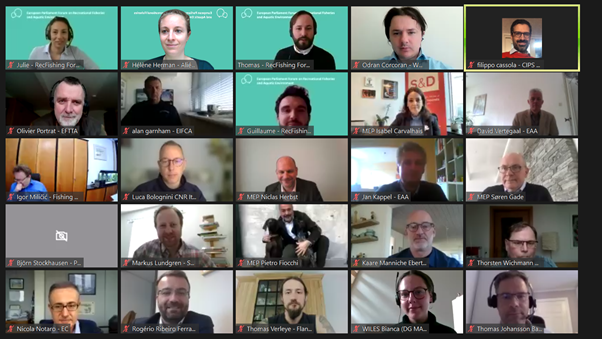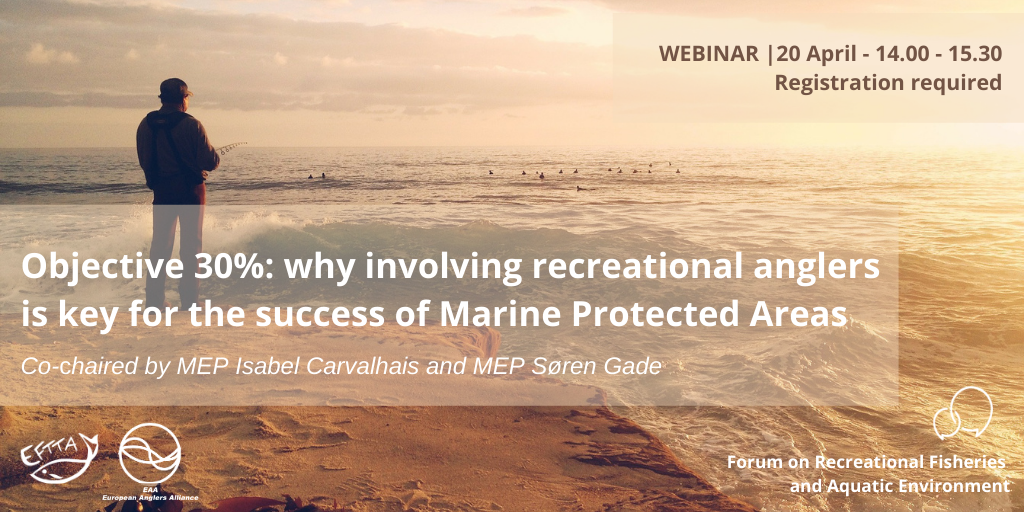Effectively protecting 30% of the EU’s sea area by 2030: recreational anglers are part of the solution
The EU Biodiversity Strategy contains ambitious targets for Marine Protected Areas (MPAs): legally protecting a minimum of 30% of the EU’s sea area by 2030, of which at least a third must be strictly protected (ie. 10% of EU’s seas). This webinar discussed the role that recreational fishing can play in achieving these objectives. It came at an important time to inform the work of the European Parliament’s report on the Biodiversity Strategy and the European Commission’s draft technical note on criteria and guidance for protected areas designations.
The report of the event is available here.
On 20 April, MEP Isabel Carvalhais (Portugal, S&D Group) and MEP Søren Gade (Denmark, Renew Europe Group) co-chaired the European Parliament Forum on Recreational Fisheries and Aquatic Environment webinar addressing the role of recreational anglers and the recreational fisheries sector in reaching the objective of protecting 30% of sea area by 2030.
In his keynote speech delivered by video message, the Portuguese Minister of the Sea, Ricardo Serrão Santos underlined that “recreational fishermen are a powerful group of stakeholders to support and contribute to conservation objectives, and for a sustainable economic development, including by raising awareness about nature and oceans. Many recreational anglers are involved in the conservation of aquatic species and habitats they depend upon.” He added that “responsible angling practices and the engagement of society in conservation initiatives benefit local communities by attracting economic activity, generating positive spill-overs throughout many sectors."
Taking up some of the points raised in the Minister’s keynote speech, Oliver Portrat, CEO of the European Fishing Tackle Trade Association (EFTTA) and David Vertegaal, Marine Public Affairs Officer representing the European Anglers Alliance (EAA), recalled the role that the recreational fisheries sector can play as a vector of acceptance by local communities and a source of economic benefits. They also called for an ecology optimised approach of recreational fishing activities in MPAs: “Do not forget that recreational fishing, and in particular recreational angling, is a very selective fishing activity. It would be ineffective to put all kinds of fishing gears, all kinds of ‘extractive’ activities on the same level and simply ban angling from these areas.” Anglers can and want to play a role in the protection of MPAs and are more than happy to be managed and controlled, through bag limits, closed fishing seasons and strict minimum sizes to contribute to the recovery of important ocean habitats and species.
MEPs Isabel Carvalhais, Søren Gade and the Chair of the RecFishing Forum, Niclas Herbst, called for the full inclusion of recreational anglers in the design and management of marine protected areas. “As anglers are often the only eyes and ears in the MPAs, they can help identify potential conservation issues. They are not the problem, they are part of the solution” said Søren Gade. Isabel Carvalhais concluded that “the protection of biodiversity is more than just a desirable goal, it is an urgent necessity. Actions must be as much daring as feasible. All sectors must be involved, including recreational fisheries.”

Watch the keynote speech by Minister Ricardo Serrão Santos:
Documents of the meeting:
Presentations:
Webinar
Objective 30%: why involving recreational anglers is key for the success of Marine Protected Areas
20 April 2021
MEP Isabel Carvalhais and
MEP Søren Gade will co-chair the webinar “
Objective 30%: why involving recreational anglers is key for the success of Marine Protected Areas” organised by the European Parliament Forum on Recreational Fisheries and Aquatic Environment, with the support of the European Anglers Alliance (EAA) and the European Fishing Tackle Trade Association (EFTTA).
Please register here.

The webinar will take place on 20 April 2021, from 14:00 to 15:30.
In May 2020, the European Commission presented its ambitious Biodiversity Strategy for 2030. In order to restore ecosystems across European seas, the Commission sets two objectives: legally protecting a minimum of 30% of the EU’s sea area, and strictly protecting at least a third of the EU’s protected areas (ie 10% of the sea).
However, existing Marine Protected Areas (MPAs) often lack the proper management and the continuous control and enforcement of conservation rules that are key for their success. The lack of funds and of involvement of national, regional or local authorities and stakeholders, also means that some of those MPAs are protected on paper only. All those challenges will not go away and will need to be addressed in order to protect effectively and efficiently the 30% of the sea needed to reach the Commission’s objectives. This also means that without an appropriate answer to these challenges, the environmental, social and economic benefits for coastal communities promised by the Commission will be limited.
As sometimes the only eyes and ears in MPAs, recreational anglers are taking a keen interest in this issue. Given that the angling experience relies on healthy fish stocks, they welcomed the Biodiversity Strategy for 2030 and intend to support and contribute to the success of MPAs in Europe.
The conference will look at the current state of play of MPAs in Europe and identify some of the keys for their success, building on the recreational fisheries sector’s experience and perspective. This will also give the opportunity to try and find the answers to some of the questions these ambitious targets raise amongst stakeholders and decision-makers. Beyond the quantitative target, the level of ambition also makes some recurring questions more acute: not all activities should be allowed in marine protected and strictly protected areas, but what should be the criteria to decide which activity to ban? On which basis should the management plans be developed, and which stakeholders should be involved? What should be the objectives of MPAs and how can their success be assessed in the mid- and long-term?